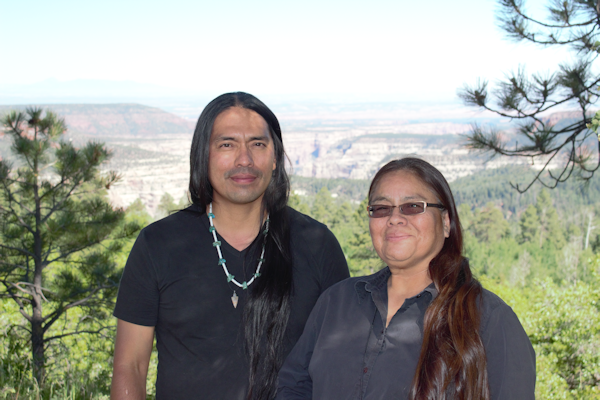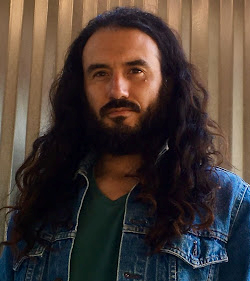SEJournal Online is the digital news magazine of the Society of Environmental Journalists. Learn more about SEJournal Online, including submission, subscription and advertising information.
 |
| To provide historical context for his story, the author conducted in-depth, in-the-field interviews in and around the Bears Ears region in Utah with Angelo Baca (at left) and his mother, Ida Yellowman. Photo: Courtesy Rico Moore. |
FEJ StoryLog: Grant Prompts Improved Coverage of Indigenous Perspectives at Bears Ears
By Rico Moore
Public lands are highly politicized. This politicization involves not only access and ownership issues, but the historical, legacy and cultural narratives connected to protected landscapes.
Indigenous communities and Native American Tribes demand their voices be heard and their narratives recognized and honored in discussions dictating policies governing and managing lands they have stewarded since time immemorial and that many still call home.
A breakout session at the 2019 Society of Environmental Journalists conference in Fort Collins, Colorado, which provided reporting guidance for covering Indigenous communities in the Bears Ears region, inspired my idea for a feature full of the cultural and environmental richness of that region. I was fortunate to receive a Fund for Environmental Journalism grant for the story.
The resulting story, “Re-Indigenizing the story of Bears Ears: One man’s mission to bring Indigenous voices to the management of their ancestral land,” ran in the Aug. 19, 2021, edition of the Boulder Weekly.
Alastair Bitsóí (Diné) referred to Bears Ears as
ancestral territory, instead of “public lands,”
accurately asserting that the Bears Ears region
was first — and continues to be — Indigenous land.
Alastair Bitsóí (Diné) served as a panelist at the 2019 SEJ session and referred to Bears Ears as ancestral territory, instead of “public lands,” accurately asserting that the Bears Ears region was first — and continues to be — Indigenous land.
Bitsóí, then the communications director for the grassroots nonprofit conservation group Utah Diné Bikéyah, or UDB, referred participants to the organization’s media orientation and cultural sensitivity sheet.
Developed to aid reporters and environmental groups covering the Bears Ears region in southeastern Utah, the document includes guidelines for working and communicating with Indigenous peoples and tribal groups, contacting sources and navigating cultural differences. It also stresses the importance of working in reciprocity with Indigenous communities.
Bitsóí also shared how an initial marketing campaign by outdoor retailer Patagonia to protest then-President Trump’s decision to shrink Bears Ears conflicted with Indigenous narratives. Upon reprisal from UDB, the company worked with Indigenous leaders to honor their narratives by integrating them into their campaign.
Collaborating helps resolve conflicts
Based on Bitsóí’s story, I decided my FEJ proposal would be a success story. It would show how conflict over narratives framing ancestral territory/public lands can turn into collaboration and mutual success, more accurately reporting on the reality of Indigenous sovereignty, indeed, amplifying it.
 |
| Author Rico Moore |
The proposal also aimed for the act of reporting to be in accordance with UDB’s media guidelines. Thus, the form of the story itself aimed to be in reciprocity with Indigenous and non-Indigenous sources alike.
By the time I began working on the story, Bitsóí had left UDB and I was referred to Angelo Baca (Diné and Hopi), UDB’s cultural resources coordinator, who was then attending graduate school in New York.
We made plans to meet in Blanding, Utah, to conduct in-depth and in-the-field interviews. Baca offered to introduce me to his mother, Ida Yellowman (Diné), who said she would be happy if I interviewed her as well.
I traveled from my home in Washington state to begin on-the-ground reporting, spending a significant amount of time talking with Baca and Yellowman in and around the Bears Ears region, photographing them along the way. Meanwhile, I communicated with Patagonia representatives via email.
Cultural sensitivity guidelines, media training used
As I adhered to UDB’s cultural sensitivity guidelines and media training, I was constantly attuning myself to the best practices for speaking with Baca and Yellowman about their culture in light of the intergenerational cultural trauma they and their family have experienced and continue to experience.
The FEJ grant afforded me an opportunity to conduct reporting that enabled me to feel and think more deeply about issues related to Indigenous rights and sovereignty.
Reporting accurately, competently and
fairly about issues like these required
decolonizing my own journalistic practices.
Reporting accurately, competently and fairly about issues like these required decolonizing my own journalistic practices; even sometimes my own perception of reality. This project gave me invaluable experience in what that looks like in practice, from beginning to end, to evolve as a reporter toward greater cultural competency and sensitivity.
In essence, this required me to be as open-minded as I could be while considering the story in the specific context of historical genocidal events that still resonate. I expanded my perspectives in order to see, feel, report and write the story as it actually was — and is.
Deeper understanding of Indigenous issues
As a result, I more deeply understood the critical importance of reporting — in the context of land management — on Indigenous sovereignty in non-Native publications, by centering and amplifying the perspectives of Indigenous people.
Oftentimes, journalists covering environmental issues in Indigenous communities and their lands “parachute in” and report in ways that Indigenous peoples find offensive (usually in a kind of extractive versus reciprocal way).
They report the story from a perspective ignorant of Indigenous culture and history and, in turn, misrepresent the subjects of the story entirely, as well as missing the mark of the story they are tasked with reporting.
Misrepresentations have policy ramifications,
in turn further alienating Indigenous peoples
from the decisions impacting their ancestral
territories and the biodiversity they defend.
These misrepresentations can form the basis of non-Native readers’ perceptions of issues involving Indigenous peoples and land management. These can have policy ramifications, in turn further alienating Indigenous peoples from the decisions impacting their ancestral territories and the biodiversity they defend.
Such reporting risks the continued silencing of Indigenous peoples and the weakening of tribal sovereignty, which began with the colonial era, continued through the industrial era and persists today in the Anthropocene, dominated as it is by biodiversity loss and fossil fuel-caused and -driven climate change.
This is especially the case with land management and natural resource decisions regarding public lands, which in most if not all cases, are the ancestral territories of Indigenous peoples who have, by and large, successfully stewarded those lands since time immemorial.
In pursuing this story grant, I sought to show — in deed and word — how to improve coverage of issues related to Indigenous sovereignty in the context of ancestral territories/public lands.
I believe the story provides a good example of what doing so might look like. Plus, by increasing my experience in this important area, I feel more confident in my abilities to report stories like this in the future.
Rico Moore is a freelance journalist based in Washington state. Broadly, his work focuses on the confluence between environment and humanity, and more specifically on climate and environmental justice. He often focuses on the cultural dimensions of these stories with an eye toward historical context. His stories have been most recently published in High Country News and appear in The Margin, Audubon Magazine, The Boulder Weekly, DeSmogBlog and The Guardian. In 2021, subsequent to his FEJ grant, Moore was appointed to the SEJ Board of Directors, where he also serves as vice president of diversity, equity and inclusion.
* From the weekly news magazine SEJournal Online, Vol. 8, No. 20. Content from each new issue of SEJournal Online is available to the public via the SEJournal Online main page. Subscribe to the e-newsletter here. And see past issues of the SEJournal archived here.













 Advertisement
Advertisement 



